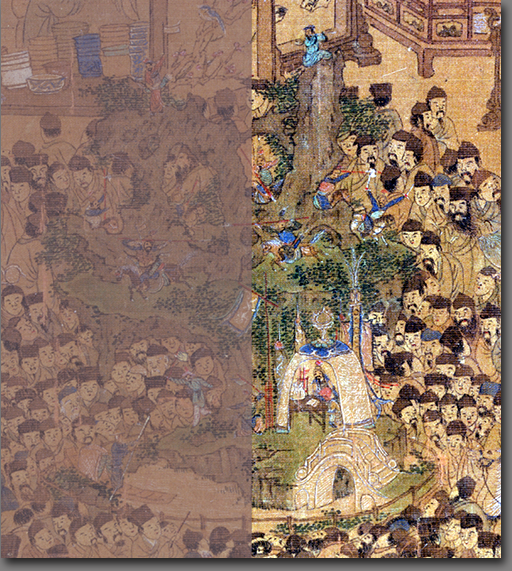Like other pieces of art I have worked with I have great respect for the effort involved in creating the ‘Colorful Lanterns at Shangyuan’ scroll painting and took great care in representing the painting as close as possible to the original. The condition of this painting has suffered considerably by age. The painting has darkened so much that the rich detail of the work cannot be appreciated in its full beauty. In its natural state, the detailed brushwork and coloring is very difficult to see with the naked eye. In examining the scroll, one may notice many stains and areas of discoloration on the scroll’s background and various areas that appear damaged or discolored. While it would have been easy to fix these damaged areas digitally, I chose to not alter the existing imperfections in the digital reproduction I created. I am truly humbled by the exquisite detail the artist(s) of this painting included in the work.
About the Digital ‘Wash and Stitch’- Process
In the spring of 2003 I was shown three photographs from the center of the painting. The photographs were average in quality and small in size. Many of the details and colors in the scroll painting are now lost to the unaided eye, so I scanned the photographs to test if I could “clean off” some of the very dark brown color seen on the original painting in order to recapture the lost detail.
I used many of the available correction tools in Adobe Photoshop in such a way as to lessen the dark brown color while retaining the rest of the colors. Since the more intense colors used in the painting are pigments made from minerals, which is the same process they still use today, I had a baseline “color chart” from which to operate.
After I had successfully developed my processes for “digitally cleaning” this painting, Mr. Jeff Hsu, the owner of the painting, was kind enough to supply us with ten individual very large Ektachrome films of the painting. The films were professionally scanned at an extremely high resolution allowing us to zoom in and clearly see the minutest details, such as the individual silk threads of the painting.
My next task was to apply the digital wash process I had created to each of the 10 scans. Unfortunately, each photograph was taken with slightly different lighting and camera position, which prevented applying the exact same process to each scan. The process for each digital wash took many, many different steps to complete.
After each scan had been digitally washed, I began the laborious task of digitally stitching the entire scanned scroll back together again. Since the scroll was photographed with a degree of barrel distortion inhibiting perfect alignment of each scan, I attempted to use professional software to compensate for the distortion. However, the software proved to produce unsatisfactory results. Therefore I had to manipulate each scan first and then stitch the images together by hand, correcting as I went. The process of digitally washing and reconstructing the scroll by stitching the scans together took approximately three months to complete.
Before and after the digital wash process.
-Garron Hale.
Social Science Instructional Labs
Eugene OR, September 2004
